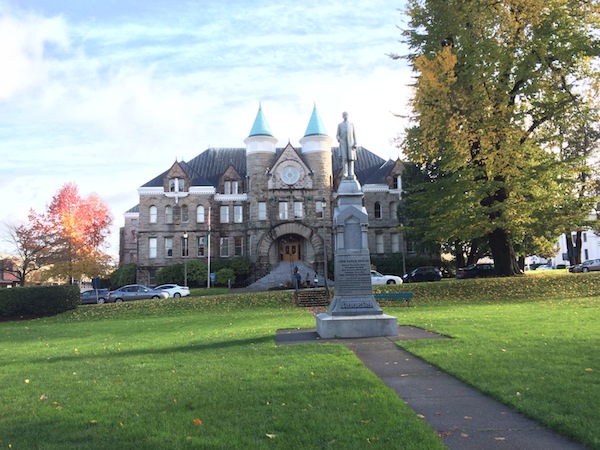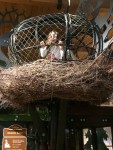At the Hands On Children’s Museu, children learn many things, including just how large a bald eagle’s nest is. (photo by Lauren Kramer)
Most small Jewish communities decrease in size over the summer, but not Olympia, Wash. The city’s Jewish population swells by up to 600 as youth from all over the Pacific Northwest and as far afield as Las Vegas converge by bus and plane on Camp Solomon Schechter, a Jewish camp founded 60 years ago.
I ventured to Olympia, a five-hour drive from Vancouver, on a stormy, grey Friday in November, looking for a weekend away from home. Camp Schechter’s sunny season was well behind us and any leisure activities were going to be determinedly indoors. Still, I witnessed a city of 48,000 with a lively, active Jewish community, two synagogues and a Chabad presence.
We stayed in the downtown core and were thrilled to attend Friday night services at Temple Beth Hatfiloh, a Reconstructionist synagogue housed in a beautiful building on 8th Avenue downtown. The rabbi was out of town and the service, led by lay leaders and attended by locals and a good turnout of comparative religions students, was filled with song. Afterwards, at the Oneg in the dining area, I learned that the building had once been home to the Church of Christian Science and was purchased, renovated and converted into a synagogue 12 years ago. Walk the sanctuary, with its high ceilings, elegant aron hakodesh and stained glass windows and you’d never know it started its life as a place of worship for another faith.

Olympia is a stately, historic city filled with soaring examples of Greco-Roman-style architecture and irresistibly browsable bookstores, galleries and boutiques. Washington’s version of Victoria, it spreads in an elegant square on either side of Budd Inlet, its beautiful state buildings on a bluff over the ocean and its 278-foot capitol dome visible from most everywhere. There are daily tours of the capitol dome and we gladly joined one led by Ed Smith, a 30-year history teacher whose father had once served in the legislature. He primed our small group on the ornate granite, European marble, carved masonry and more than 300 Tiffany lights and chandeliers that decorate the palatial interior. It’s an impressive place and one that certainly lends gravity to Washington’s history and the business of lawmaking.
It was less than fascinating for a 6-year-old, though, which is why our next stop was the very antidote: the Hands On Children’s Museum of Olympia. These days, almost every city has a generic children’s museum – but this one is far from generic. “Our goal was to only feature exhibits from the Pacific Northwest, things children might see in their own back yards,” said Jillian Henze, communications manager for the 28,000-square-foot museum. Best suited for the 3-to-8-year-old crowd, this innovative space delves into the farm to fork eating experience, the Puget Sound waterway, the forest and the lifecycle of water. Children learn how currents flow, how large a bald eagle’s nest really is, how water and wind pressure work, how to build a house and where food comes from. My daughter Maya had to be dragged out of the museum at closing time.
We left Olympia the next day for Grand Mound, 20 minutes away and home to Great Wolf Lodge, Washington’s equivalent to Disneyland. The massive indoor waterpark is a kids’ paradise, with waterslides that sweep riders on circuitous watery journeys, a large wave pool and two well-designed water play structures – one for toddlers and the other for kids 7 and younger. There’s easily enough entertainment in the waterpark alone for a half-day. But, once you dry off, there’s more to do in the rest of the resort. Around us kids were running about with wands, pointing them at treasure chests and learning their way around a game that lasts four to six hours and occupies them for the duration of their stay. Great Wolf is a hedonistic kids’ experience from which parents emerge looking flushed and exhausted from the combination of heat, chlorine and noise. By contrast, their kids come out starry-eyed and determined to return.
We took the long road back to Olympia on Old Highway 99 to get a glimpse of Tenino, a sleepy city with a fascinating history. I was anxious to learn about Tenino’s sandstone legacy, which dates back to 1888 with the discovery of a large deposit of sandstone – a valuable commodity in the pre-concrete era. In the four decades that followed, Tenino quarries supplied sandstone for buildings in San Francisco and Vancouver, B.C., among other places. The quarries closed in the late 1920s but one of them, the Tenino Stone Company Quarry, was deliberately flooded with water from natural springs by the City of Tenino. It became a 95-foot-deep swimming pool with terraced walls that bear evidence of its history. Unfortunately, most of that history remained an enigma because the doors of the Tenino Depot Museum, usually open on the weekends, were shuttered when we were in town. That’s the problem with sleepy cities, particularly in November. They tend to go into a long hibernation.
Lauren Kramer, an award-winning writer and editor, lives in Richmond, B.C. To read her work online, visit laurenkramer.net.
If you go …
- For general information on Olympia, surf to visitolympia.com
- The Hands On Children’s Museum is open daily until 5 p.m. and admission is usually $10.95 US, but is free on the first Friday evening of every month from 5-9 p.m.: hocm.org or 1-360-956-0818
- Free tours of the Washington State Legislative Building run every hour on the hour from 10 a.m.-3 p.m. weekdays; 11 a.m.-3 p.m. on weekends
- You have to stay to play at Great Wolf Lodge, where accommodation starts around $210/night for a family of four to six people, and includes water park passes: greatwolf.com or 1-866-798-9653

